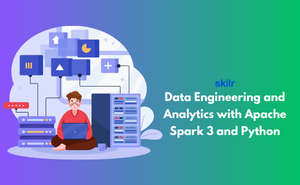👇 CELEBRATE CLOUD SECURITY DAY 👇
00
HOURS
00
MINUTES
00
SECONDS

Data Engineering and Analytics using Apache Spark 3 and Python focuses on turning massive volumes of raw data into valuable knowledge. Data Engineering deals with collecting, structuring, and preparing information so that it can be used effectively. Analytics, on the other hand, extracts key insights from this prepared data. Apache Spark 3 is a modern tool designed to handle large-scale data processing at high speed, while Python makes it easy to code, analyze, and create visual reports.
Professionals who master these tools are able to manage complex datasets, clean and transform them, and then uncover patterns that drive decision-making. The certification equips candidates with hands-on skills to apply Spark and Python for solving practical data challenges.
This exam is ideal for:
Industry-endorsed certificates to strengthen your career profile.
Start learning immediately with digital materials, no delays.
Practice until you’re fully confident, at no additional charge.
Study anytime, anywhere, on laptop, tablet, or smartphone.
Courses and practice exams developed by qualified professionals.
Support available round the clock whenever you need help.
Easy-to-follow content with practice exams and assessments.
Join a global community of professionals advancing their skills.
No, Spark concepts will be taught from the basics.
Yes, it is beginner-friendly, provided you have some programming background.
Yes, basic knowledge of Python will help, though advanced coding is not required.
It’s for professionals or learners who want to work in data roles like Data Engineer, Analyst, or Big Data Developer.
Yes, the certification includes projects and case studies from real industries.
Roles like Data Engineer, Big Data Analyst, Spark Developer, and ML Engineer.
It focuses specifically on data engineering and analytics using Spark with Python, not just programming basics.
Spark can work on both small and large datasets, but it is especially useful for massive datasets.
Finance, healthcare, retail, telecom, IT services, and e-commerce.
Spark handles large-scale data efficiently, and Python makes it easier to work with that data using simple code.